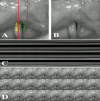Voice Recovery in a Patient with Inhaled Laryngeal Burns
- PMID: 30783600
- PMCID: PMC6368980
Voice Recovery in a Patient with Inhaled Laryngeal Burns
Abstract
Introduction: Laryngeal burns cause long-term voice disorders due to mucosal changes of the vocal folds. Inhalation injuries affect voice production and result in changes in the mucosal thickness and voice quality.
Case report: A 47-year-old woman was transferred to our department with laryngeal burns sustained during a house fire. On laryngoscopic examination, mucosal waves of both vocal folds were not visualized due to the injury caused by inhalation of high-temperature toxic smoke. Hence, voice analysis, laryngoscopic examinations, and high-speed videoendoscopy (HSV) were performed to evaluate vocal fold vibrations. An absence of mucosal waves and a breathy and strained voice with a severe grade were noted. We report that voice quality was recovered to close to the normal state through multiple treatments such as medication, voice therapy, and counseling.
Conclusion: This paper presents the unique case of a patient with laryngeal burns, in which vibrations of the vocal folds were observed using laryngoscopic examination and HSV. Voice samples before and after treatment were also analyzed. By observing the vibration pattern of the injured vocal fold, it is expected that appropriate diagnosis and treatment planning can be established in clinical practice.
Keywords: Dysphonia; Inhalation Burns; Laryngoscopy; Larynx.
Figures



Similar articles
-
Vibratory Onset of Adductor Spasmodic Dysphonia and Muscle Tension Dysphonia: A High-Speed Video Study✰.J Voice. 2020 Jul;34(4):598-603. doi: 10.1016/j.jvoice.2018.12.010. Epub 2018 Dec 28. J Voice. 2020. PMID: 30595236
-
Laryngeal High-Speed Videoendoscopy with Laser Illumination: A Preliminary Report.Otolaryngol Pol. 2021 Sep 7;75(6):1-10. doi: 10.5604/01.3001.0015.2575. Otolaryngol Pol. 2021. PMID: 35175220
-
Functional Voice Disorders.2023 Apr 28. In: StatPearls [Internet]. Treasure Island (FL): StatPearls Publishing; 2025 Jan–. 2023 Apr 28. In: StatPearls [Internet]. Treasure Island (FL): StatPearls Publishing; 2025 Jan–. PMID: 33085329 Free Books & Documents.
-
What have we learned about laryngeal physiology from high-speed digital videoendoscopy?Curr Opin Otolaryngol Head Neck Surg. 2005 Jun;13(3):152-6. doi: 10.1097/01.moo.0000163451.98079.ba. Curr Opin Otolaryngol Head Neck Surg. 2005. PMID: 15908812 Review.
-
Aerodynamics, voice quality, and laryngeal image analysis of normal and pathologic voices.Curr Opin Otolaryngol Head Neck Surg. 2004 Jun;12(3):166-73. doi: 10.1097/01.moo.0000122306.42961.44. Curr Opin Otolaryngol Head Neck Surg. 2004. PMID: 15167024 Review.
References
-
- Nottet JB, Duruisseau O, Herve S, Patuano E, Ainaud P, Carsin H, et al. Inhalation burns: apropos of 198 cases Incidence of laryngotracheal involvement. Ann Otolaryngol Chir Cervicofac. 1997;114:220–5. - PubMed
-
- Hogg G, Goswamy J, Khwaja S, Khwaja N. Laryngeal Trauma Following an Inhalation Injury: A Review and Case Report. J Voice. 2017;31:388. - PubMed
-
- Casper JK, Clark WR, Kelley RT, Colton RH. Laryngeal and phonatory status after burn/inhalation injury: a long-term follow-up study. J Burn Care Res. 2002;23:235–43. - PubMed
-
- Valdez TA, Desai U, Ruhl CM, Nigri PT. Early laryngeal inhalation injury and its correlation with late sequelae. Laryngoscope. 2006;116:283–7. - PubMed
-
- Pfannenstiel TJ, Gal TJ, Hayes DK, Myers KV. Vocal fold immobility following burn intensive care. Otolaryngol Head Neck Surg. 2007;137:152–6. - PubMed
Publication types
LinkOut - more resources
Full Text Sources
